Stan the Man and an L.A. boy
January 24, 2013
“I’d like to talk to Stan Musial.”
I was a baseball-crazed 11-year-old when I made that pronouncement to the telephone operator at the old Hotel Statler at Wilshire and Figueroa. I’d learned from a feature in the Sporting News that the St. Louis Cardinals were staying there during a series with the Dodgers—and I was determined to talk to Stan the Man, the visiting team’s star outfielder.
The nickname was spot-on. During a career spanning more than two decades, Musial would ultimately win seven batting titles, appear in 24 All-Star Games and set scores of records. He was that rare player who was elected to the Hall of Fame on the first ballot. Still, despite the gaudy numbers, he was also known as a humble gentleman, with little of the flash of such famous contemporaries as DiMaggio, Mantle and Mays. Musial spoke softly but carried a very big stick.
So I guess I shouldn’t have been surprised when he picked up the phone in his hotel room. But I was. He caught me off guard in my ruse as a radio sportscaster named Bob Price. (I didn’t think he’d bite on a name like Zev Yaroslavsky.) Trying my best to sound older than my pre-teen years, I asked a series of questions about the team’s strengths. He thoughtfully answered each, offering particular praise for a young right-handed pitcher named Bob Gibson, who’d one day join him in Cooperstown. Because I didn’t expect to actually talk to Musial, I quickly exhausted my list of questions.
I closed the “interview” by melodically saying, “Thank you, Stan Musial, for being on our sports show.” To which he said: “You’re welcome, son.” Turns out, he’d been playing along from the start, so free of self-importance that he was willing to take a few moments to give a kid a memory of a lifetime. Imagine that.
Last Saturday, at the age of 92, Stan Musial passed away, and that memory from the late 1950s came back to me with the power of one of his mighty swings. I know that, given the security concerns of today, such a phone conversation between a boy and a ballplayer would be highly unlikely. But I also wonder how many of our super-star athletes even recognize, as Musial did, the obligations that come with fame. Celebrity is not an entitlement. Forgive the cliché, but whether in sports or politics, you’ve got a responsibility to be a role model for those who look up to you.
Two years ago, this quality in Musial was recognized in a White House ceremony by President Obama, who presented him with the nation’s highest civilian award, the Medal of Freedom. Obama described Musial as “untarnished, a beloved pillar of the community, a gentleman you’d want your kids to emulate.” For my part, I’ve given it my best.
Sometimes, when I get a late-night call from a constituent with a problem—and they’re not play-acting—I think back to that day when Musial found time to talk to a young kid. And then I try to step up to the plate, too. Now 64, I’ll be forever grateful to the ballplayer who demonstrated what being a man is really about.
Posted 1/24/13
Board orders audit of sheriff’s budget
January 23, 2013

Sheriff patrols have been reduced throughout the county's unincorporated areas. Photo/Navymailman via Flickr
After a testy public confrontation with Los Angeles County Sheriff Lee Baca over patrol cutbacks, the Board of Supervisors unanimously called for a “forensic audit” of his department’s $2.8 billion budget.
The Tuesday action came after several supervisors accused the sheriff of potentially jeopardizing public safety by reducing the number of patrol cars in the county’s unincorporated areas to save money on rising overtime costs.
Baca insisted that, with crime rates down substantially, there was little danger that fewer patrol cars would lead to higher public risks. He said he had no choice after being hit with multimillion dollar budget cuts for three consecutive years and unacceptable overtime costs in recent weeks.
“We have the largest county in the United States, and the safest county in the United States,” Baca said, adding: “I just believe we need to account to [the public] as to what we’re doing and what are the true facts regarding their safety.”
Although the Board of Supervisors sets the department’s budget, the sheriff has wide discretion over how it’s actually spent.
During Tuesday’s Board hearing, Baca faced the stiffest criticism from Supervisor Gloria Molina, whose district includes the unincorporated community of East Los Angeles, among others.
“I’d like to cut your budget in other places and I’m going to try and find a way,” warned Molina, who joined with colleague Don Knabe in introducing the motion for an independent audit of the department’s budget.
Both Molina and Knabe suggested that Baca was undermining an “equity policy” ensuring that unincorporated areas get the same level of services as cities that contract with the department. Instead, Molina said, costs are being reduced in unincorporated areas to subsidize other department functions and responsibilities.
“You are stealing,” she told the sheriff, who responded: “Stealing is over the top, supervisor.”
“I want you to let me finish,” Molina interrupted.
“Not when you say something that is so outrageous that it’s not worth the dignity of your office,” the sheriff said.
Later, Molina apologized for the “stealing” characterization, and Baca thanked her for being a “stellar supporter” of the department. The sheriff also assured the board that he was already taking measures to ensure that patrol levels would not be reduced for long, including in the unincorporated area of Topanga Canyon in Supervisor Zev Yaroslavsky’s district. The vast majority of his district is patrolled by the Los Angeles Police Department.
No date was set for completion of the independent audit, which will be arranged through the county’s Auditor-Controller’s Office.
Posted 1/23/13
Westward ho for CicLAvia
January 17, 2013
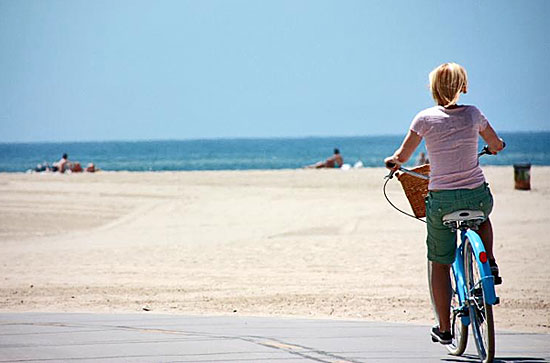
Manifest destiny: CicLAvia's getting ready to roll all the way to the coast. Photo/planetc1 via Flickr
Saddle up, Westsiders: L.A.’s favorite rolling street party is headed your way in April.
CicLAvia, the car-free bicycle and pedestrian fest started in 2010, is on the move again, preparing for its most ambitious year yet with three events, including one that will stretch from downtown to Venice Beach on April 21.
It’s part of a major expansion that organizers hope eventually will stretch to all corners of the county and create 12 separate, localized CicLAvias each year.
“Up till now we’ve been downtown. Now we want to show that it will work in the rest of the region,” said Aaron Paley, CicLAvia’s co-founder. A second 2013 CicLAvia is being planned for June 23 with a new route expected to run along Wilshire Boulevard from downtown L.A. to Fairfax Avenue near LACMA. And this year’s third event, on October 6, will return to familiar territory downtown, although with a deeper stretch into Boyle Heights and a new route into Chinatown.
The downtown-to-Venice Beach route will be the longest yet for CicLAvia—15 ¼ miles each way—and carries with it some important cross-town symbolism.
“One of the things that’s exciting about connecting downtown and the Pacific is just the sheer drama and the significance of it,” Paley said. “We know that the east-west connection is very difficult and for people who drive it every day, it’s a challenge…The idea that you will be able to walk or ride your bike—or go in your wheelchair or do your inline skating—and go from downtown to the beach is just of historic significance.”
Venturing out on such a long ride should be attractive to many participants, but Paley said the event is more about creating a pop-up “linear park” on city streets than throwing down an endurance challenge.
“This isn’t the marathon. It isn’t all or nothing,” he said. “We want kids to be able to explore, maybe get out and ride in the streets for the first time that day. And if they ride a half mile, that’s great.”
The hope is that participants will arrive via public transportation if possible—perhaps by taking the Expo Line to the Culver City station at Venice and Robertson, or riding the bus to the Pico/Rimpau Transit Center at Venice and San Vicente.
Paley said the impetus for pushing outside the downtown zone and toward the ocean this year came from Los Angeles Mayor Antonio Villaraigosa, who kept asking: “When can we go all the way to the beach?”
The mayor, he said, even burst into a planning meeting to promote the idea—prompting a round of brainstorming in which the Department of Transportation’s special events traffic guru, Aram Sahakian, came up with the idea of using Venice Boulevard, a route traveled by other events like the Los Angeles triathlon.
“We’ve used it before. We know exactly what we’re dealing with,” Sahakian said.
Taking the route deep into the Westside—where traffic woes are among the city’s worst—will require plenty of outreach to make sure residents and businesses know what’s coming. “I’m crossing my fingers and praying that they won’t be too unhappy,” Sahakian said.
So far, so good, said Diana Rodgers, who manages the Mar Vista Farmers’ Market and is enthusiastic about the coming of CicLAvia to her area.
“We love it and we want to be a partner and provide refreshments,” she said.
The farmers’ market, which takes place on Sundays and is located on Venice at Grand View Boulevard, is accustomed to rolling with the closures that come with big events like the marathon and triathlon, Rodgers said, and should be able to take CicLAvia in stride.
“As long as we have the information, we tend to do OK, as long as we have crossing guards at the points needed,” Rodgers said.
Westside cyclists like Cynthia Rose, director of the group Santa Monica Spoke, said the new route will be a big draw in her part of town.
“There’s a huge pool of enthusiastic Westside supporters and they’ve felt sort of geographically separated,” she said. “Now all of a sudden it’s going to be that connecting of the dots, from the ocean to downtown Los Angeles.”
Paley said the final map for the downtown-to-Venice Beach route is still being fine-tuned. The CicLAvia team will be taking an exploratory ride along the proposed route Sunday to see how it works and connects with two major hubs downtown—City Hall and Union Station.
Beyond the 2013 lineup, he’s looking forward to CicLAvia’s gradual multi-year expansion.
“We want the entire county to be able to benefit from Ciclavia,” Paley said.
So what’s on tap for 2014? “I can tell you that the Valley,” Paley said, “is high on our list.”
Posted 1/17/13
Grand plans for Grand Park
January 17, 2013
“All politics is local,” or so goes the saying coined by the late House Speaker Tip O’Neill.
This Monday, January 21, the newly-minted Grand Park will embody that maxim at “Hail to the Chiefs,” a community celebration of Martin Luther King Day and President Obama’s inauguration. The program will feature musicians including hip-hop artist Mathai, who’ll incorporate King’s “I Have A Dream” speech into his act. DJ Anthony Valadez of public radio station KCRW will drop clips of Obama’s inauguration into his typically eclectic set. Attendees will be invited to write their thoughts in a “Letter to the Prez,” a large scroll that will be delivered to the White House.
“Hail to the Chiefs” will mark the second installment of the “Park Your Politics” series, which was launched on election night last year. It’s one of a number of evolving programs aimed at attracting diverse audiences to the park, which fully opened last October.
“The idea of coming together to celebrate those moments that are memorable, that’s the thing we want to create in the park,” said Lucas Rivera, the park’s director. “We want to be the place that, when you are older and reminiscing, you’re telling the kids about your time in Grand Park.”
So far, the park has hosted 23 events, attracting an estimated 30,000 visitors, in addition to those who’ve been participating in a number of ongoing programs in the park, such as noontime yoga.
The biggest draw so far was the National Dance Day Celebration, which kicked off the park’s grand opening and featured “So You Think You Can Dance’s” Nigel Lythgoe. The audience-participation event attracted about 5,000 dancers and onlookers. The election night party, meanwhile, drew about 2,000 celebrants and coverage on CNN. Some events that organizers predicted would have modest turnouts have performed better than expected. They anticipated, for example, that about 20 dogs and their owners would show up for a “Pooch Party” but ended up with more than 100.
Julia Diamond, Grand Park’s programming director, said the park’s most immediate beneficiaries have been its “captive audience,” the people who work, play and do business in the surrounding buildings, like the courthouse, Hall of Administration, Music Center and City Hall.
Music Center staff members, who handle programming for the park, pride themselves on reaching a wide audience with diverse entertainment and activities. In the end, though, it’s all about growing a sense of community at downtown L.A.’s largest outdoor public venue.
“The park should always be fun and multi-sensory—great music, great food and playing with the dog you’re going to bring,” Diamond said. “The way we design our events, we let people have a hand in how they design their experience.”
For the future, Rivera and Diamond envision literacy programs for children, events for seniors, arts and crafts festivals and programming featuring the interactive Arthur J. Will Memorial Fountain. The park also has begun the process of getting its own farmers market. As for the “Park Your Politics” series, plans are in the works for live debates with local high school and university students and a speaker series based on whatever’s “hot” in politics at the time.
Larger offerings also are on the horizon, including events on the 4th of July and New Year’s Eve, which Diamond said wasn’t done this year because the park was just getting its staff in place.
“When we do New Year’s Eve,” Diamond said, “we want to do it really well.…Every event we get to know our audience a little better; every event we get to know our space a little better. What Grand Park is to me is a gathering place, and our city really doesn’t have another natural spot to gather.”
Posted 1/17/13
A passage to India
January 16, 2013
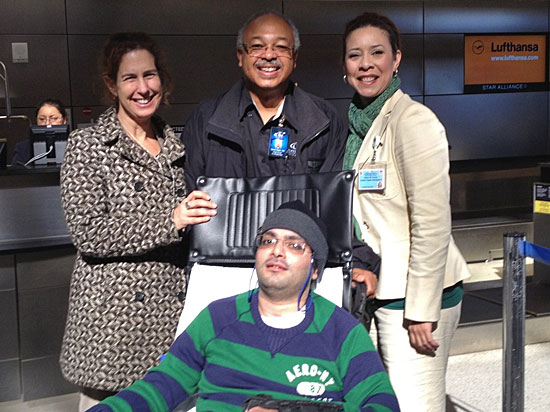
Vishal Makhija at LAX. With him are, from left, LAC+USC Social Work Supervisor Jan Crary, flight nurse David Hogan and Assistant Hospital Administrator for Medical Services Sandy Correa.
Vishal Makhija is going home.
He journeyed to Los Angeles in 2009 with dreams of becoming an accountant. Instead, he spent the past nine months at Los Angeles County+USC Medical Center—his body broken, his brain permanently damaged from a hit-and-run driver who mowed him down during an evening walk. On Wednesday morning, Makhija’s stay came to an end as he was gently lifted into a special medical transport jet bound for Mumbai, India, where his family will give him the constant care he now needs.
The $19,200 trip is being underwritten by Los Angeles County.
“Our family is middle class by Indian standards but, for us, the cost was out of the question,” says Kiran Makhija, who has lined up a nurse, a physical therapist and a specialized hospital bed in India for her 32-year-old brother. “This is a huge relief, and we are very grateful. I am 100 percent sure that Vishal will heal better and faster with family and friends who love him here.”
Makhija’s case represents an innovative effort by top county health officials to reduce hospital costs while improving patient outcomes for large numbers of hard-to-place indigent patients who are taking up public hospital beds longer than medically necessary.
Dr. Mitchell Katz, director of the county’s Department of Health Services, says he hopes to create a special fund in his budget for “creative discharges” like Makhija’s that, with some imagination, could be solved in ways that do right both by the individual patient and by the county’s limited pool of health care resources.
“Of course, each case is different,” Katz says. “There isn’t a cookie-cutter solution.” Housing and special placements have their own price tags, he notes, and sometimes the circumstances and the medical needs will make the hospital the most cost-effective decision.
“You have to look at each person and figure out what they need,” he says. “But once you’ve figured that out, if there’s a solution that’s substantially less expensive, you should be able to move on it.”
Dr. Christina Ghaly, LAC+USC’s interim chief executive, says that on any given day, approximately 10% of the hospital’s acute care medical beds, and about half of its acute care psychiatric beds, have been occupied for weeks or months by patients who should be in a lower level of care but have no provider willing to take them.
Because LAC+USC is a hospital of last resort for the impoverished, homeless and poorly insured, its rate of hard-to-place patients is far higher than that of private medical centers. At any given time, there are as many as 60 patients like Makhija, who not only increase the public hospital’s costs but also crowd out patients in need of acute beds. Some have remained hospitalized for so long that they’ve lost their housing. The county’s other three public hospitals fare little better, says Ghaly: “There’s a patient at Olive View whom we’ve been trying to place now for two years.”
Katz says he has been concerned about Los Angeles County’s high numbers of hard-to-place patients since he arrived here from San Francisco two years ago. Aside from the financial issues, he says, overlong hospitalizations can have serious medical and psychological downsides for patients, including risk of infection, atrophy and disorientation.
“When I would ask about why we weren’t sending someone to supportive housing or a board and care, or why we weren’t sending people home to be reunified with family, I was told, ‘Well, the county is in the midst of a fiscal crisis and we don’t have the budget.’ But that has never made any sense to me, because, of course, the most expensive thing to do is to keep people in the hospital.”
So the county has begun exploring alternatives, from “respite” beds where homeless convalescents can recuperate in their own bedrooms like more fortunate patients to providing financial incentives to skilled nursing facilities for taking difficult or poorly insured patients. Katz estimates that broadening the options for lower levels of care could save the county “tens of millions of dollars” while improving patient care.
The push is especially important in the wake of the federal Affordable Care Act, which promises to change the business model for health care providers by, among other things, accelerating the trend toward lump sum allotments for patients and procedures, rather than reimbursement for days in a hospital bed or fees for a medical service.
“But it’s not just about money. It’s about finding the right place for the person,” Katz says.
Finding a place for Makhija was especially frustrating because, unlike many indigent patients, his relatives were ready and willing to care for him, says interim CEO Ghaly. “The problem,” she says, “was mainly logistical.”
In fact, Makhija was planning to return to India, according to his sister. “Nothing was going right for him there,” says Kiran Makhija, an account manager for a public relations firm in Dubai.
“He used to dream, talk, visualize, live and breathe U.S.A.,” she says. “He was the biggest fan of Oprah Winfrey and would lay awake late at night watching U.S. destinations on the Travel channel.” But after spending four years in New Jersey on a visa to work and study accounting, she says, he was laid off during the 2008 financial crash and never recovered.
He moved to Los Angeles, hoping to find work, but couldn’t muster more than low-paying jobs in retail, according to Sahib Dudani, a family friend in Laguna Hills to whom Makhija had reached out. Dudani says the young man was living in a rented room in the Boyle Heights apartment, a few blocks from the site of the April 18, 2012, accident.
Hospital records show that paramedics rushed Makhija to the emergency room at 4:25 a.m. after a passerby saw him lying unconscious in an intersection near Soto Street and the I-10 Freeway. His legs were broken, his brain was traumatically injured and his body was marked with tire tracks, but no witnesses came forward and no arrests were made.
“He was coming to me [on the week of the accident] so I could advise him on his next step, including possibly going back to India,” says Dudani, a computer scientist who had known Vishal’s aunt in Mumbai. “When we didn’t hear from him for a couple of days, we got very concerned and went to his address.”
Kiran Makhija says family members were frantic when they learned what had happened, but their applications for emergency visas repeatedly denied. “They said he was in the U.S. illegally, so no one in the family could come for him. But he had a valid green card.”
When her brother emerged from intensive care after a month, the family began brainstorming ways to get him back to India. Kiran, who had been working in Mumbai, took a higher-paying job in the United Arab Emirates, realizing her semi-retired parents would need the extra money.
But as months passed, it became clear that Vishal would never be able to get on a commercial airplane. Although he begged to come home, his injuries had left him impulsive and unable to sit up for more than three hours at one time. He was incontinent and could not move without a specialized stretcher and wheelchair. An international air ambulance would cost tens of thousands, if not hundreds of thousands, of dollars—an impossible sum either way for the family.
Meanwhile, hospital social workers also were running out of options. Makhija had Medi-Cal coverage, but it would only reimburse for hospitalization that was a medical necessity.
By now it was November and the hospital’s unreimbursed costs were approaching $300,000. Every day, social workers were calling ten or more nursing facilities throughout the state, but none would take him. Such facilities, which typically care for elderly patients, resist taking younger, more labor-intensive clients, particularly those with permanent brain injuries and public insurance, such as Medi-Cal, that reimburses far less than private policies, Ghaly says.
“Finally, we exhausted all other efforts and started thinking outside the box,” says Cecil Clark, an associate hospital administrator at LAC+USC.
Clark says that as he cast about for ideas from his team, Sandy Correa, who had come on board the month before as an assistant hospital administrator for medical services, piped up with a question: If Makhija wanted to go home, and his family couldn’t come and retrieve him, why couldn’t the hospital take him to them?
The specialized transport she eventually found, Florida-based Commercial Medical Escorts, Inc., was substantially cheaper than an air ambulance—and less than half the monthly cost of Makhija’s bed at LAC+USC. He’ll be able to lie flat as much as necessary during his journey and will be accompanied by a nurse from Los Angeles to Mumbai, where he is scheduled to land early Friday.
Although such escorts are often used by other hospitals, health services director Katz says they are a departure for Los Angeles County. He says it took more than a month to get all the necessary approvals inside the bureaucracy but the alternative was for the county to foot the bill for Makhija to spend the rest of his life in an institution.
“It is not right to spend all that time in a hospital doing nothing,” says Kiran Makhija. She and her parents are now counting the days until Vishal’s challenging homecoming. “We are not the kind of family that would leave my brother alone.”
Lying in his hospital bed on a recent afternoon under the watchful eye of a nursing attendant, Makhija says he has no memory of the accident that maimed him, but confirms that he wants to return to Mumbai.
“I don’t want to live here,” he says. “I don’t have a job here. I want to go home.” He says he has spoken to his sister about the arrangements and that he’s “very excited.” Asked what he remembers about Mumbai, he replies simply: “It is beautiful.”
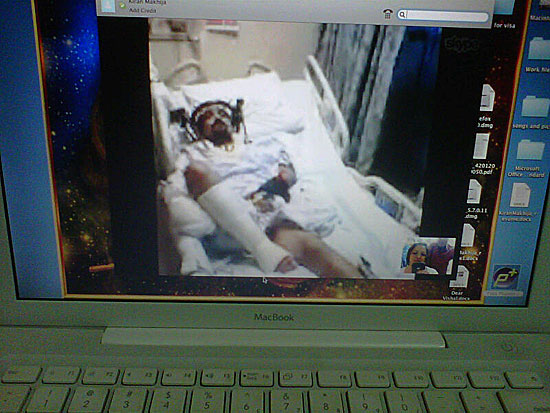
Makhija Skypes with his sister in India, Kiran Makhija, who has lined up a nurse, a physical therapist and a specialized hospital bed for him.
Posted 1/16/13
Getting schooled in the Pass
January 15, 2013
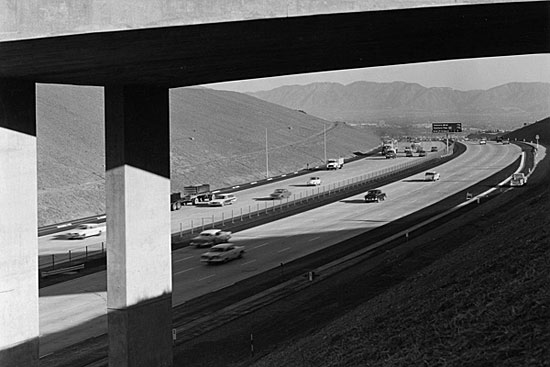
The 405 Freeway through the Sepulveda Pass, shortly after the Mulholland Bridge opened in 1960. Photo/Metro
Pop quiz, kids. Grab your No. 2 pencil and turn your attention to one of the 405 Freeway’s most fabled stretches. The Sepulveda Pass is:
a) A crucial thoroughfare between the Westside and the San Fernando Valley
b) Part of a long-running $1 billion-plus construction project
c) The hill L.A. commuters love to hate
You don’t have to be a drive-time traffic reporter to know that the answer is “all of the above.” But if all you know about the Sepulveda Pass is what you’ve seen through your car’s windshield, an upcoming course at the Skirball Cultural Center aims to unspool the mysteries—historic, geographic, and cultural—behind an essential piece of the Los Angeles landscape.
“The Sepulveda Pass: From Creation to Carmageddon” will be held on four Sunday afternoons beginning February 10. The instructor is Erik Greenberg, director of education at the Autry National Center, who aims to take students on a tour of the Pass from its geologic beginnings through centuries of human history, including its emergence as an important center of Jewish life in Los Angeles as home to institutions including the American Jewish University, Stephen S. Wise Temple and the Skirball.
“The Pass plays an important role in the lives of lots and lots of people,” said Greenberg, pointing out that the stretch has been called “L.A.’s Brooklyn Bridge—dividing people and uniting people.”
Adele Lander Burke, vice president of the Skirball’s “Learning for Life” adult education program, said it was high time to explore the Pass.
“I think it’s on people’s minds a lot,” she said. “We lived through two Carmageddons and did quite well…also, it’s on Sundays. There’s no construction going on during the weekend, so it’s very easy access.”
The four-session class costs $60 for Skirball members, $75 for non-members. Bragging rights for your next commuting gripe session: priceless.
Posted 1/15/12
A legacy of California gold
January 10, 2013
The obituaries told us that he’d been a fixture on local television since the early 1980s, but I could have sworn that Huell Howser had been a part of our family for a lifetime. It felt like I’d been a fan of his for that long. When Huell generously agreed to preside over my swearing-in as a newly-minted County Supervisor in 1994, it was one of the high points of my political career.
Huell came from sturdy American stock. He was born in Gallatin, Tennessee, established in 1802 as the county seat of Sumner County and named for Albert Gallatin, a Secretary of the Treasury under Presidents Thomas Jefferson and James Madison. Maybe it was that kind of rich history and sense of place you find in so many Southern towns that helped develop this country boy into the gifted storyteller that enchanted the city slickers here in Los Angeles for so many years.
Huell and I shared a deep fascination with history in our college studies, and he earned his undergraduate degree in it from the University of Tennessee in Knoxville. After a stint in the Marine Corps and serving on the staff of Sen. Howard Baker—one of my Watergate heroes—he embarked on a career in TV news, working locally in Nashville before graduating to New York.
In 1981, he came to Los Angeles as a feature reporter for KCBS-TV, but soon found that the hustle of local TV news and its obsession with crime and celebrity fluff wasn’t his thing. In 1985, he found a happier home at KCET, then the Southern California flagship station for PBS. There he created a wide variety of feature programs like Videolog, California’s Gold and others, and finally hit his stride as a joyful chronicler of all things California, from quirky people and offbeat occupations to spectacular natural wonders and all manner of outdoor adventures.
With his shades, Hawaiian shirts, shorts or khakis, he was like a slightly goofy tour guide for a statewide vacation that never ended. There was nowhere he wouldn’t go, nobody he wouldn’t talk to. He was always friendly, cheerful, courteous and somehow incredibly interested and excited to learn about the most obscure places, occupations or activities.
Everything was “amazing” to Huell—“Oh, my gosh! Would you look at that!” he would always exclaim. It’s been said many times, but I honestly think it was Huell’s sense of innocence and wonder that was the key to his enduring and universal appeal. It wasn’t an act. There was nothing cynical, ironic or post-modern about it. This wasn’t the “Daily Show.” Off-camera—and I know, since we were friends and practically neighbors when he was staying at the grand old El Royale Apartments on Rossmore—he was exactly the same earnest and charming guy that you saw on screen.
Huell may have been born in Tennessee, near the cradle of the Confederacy, but he became by choice an adopted son of the Golden West. Maybe that’s why he had so much respect and admiration for the wonderful things too many of us native Californians take for granted.
It was easy to make fun of his folksy, “gee-whiz” manner, but you just had to spend five minutes with him to know that it was no put-on. His segments were just as honest and straightforward, strictly do-it-yourself productions—Huell and a camera guy, basically—but who needed all the other bells and whistles? The classic storytellers of ancient times required only a campfire, an audience, and a story to tell.
Though he became a genuine TV star, he never lost his modesty or humility. As he was winding down his career, he donated his tapes, books, and even his spectacular Volcano House home in the desert to Chapman University. Nearing the end, he instructed his colleagues that he wanted no ceremony or memorial, public or private, and he asked close friends to honor his wishes that they not participate. He just wanted people to watch his shows and enjoy the stories. That’s the only tribute he wanted.
When we first learned of his retirement in November, we hoped to honor him at the Board of Supervisors. We couldn’t have known at that time that he was already too ill to participate.
Now he’s gone, and it feels like we’ve all lost a cherished friend. So let me just say: “Happy trails, Huell.” You’ve left behind a wonderful legacy.
Posted 1/10/13
Supervisors back assault weapons ban
January 10, 2013
The Los Angeles County Board of Supervisors this week signaled its support for legislation to reinstate the nation’s ban on assault weapons.
Supervisors also ordered a safety assessment of county facilities and a report on protocols for dealing with gun-related security breaches at each of them.
The actions come in the wake of the Newtown, Connecticut, shootings in which 20 children and six adults were killed at Sandy Hook Elementary School by a heavily-armed gunman on December 14, 2012.
On Tuesday, Supervisor Zev Yaroslavsky successfully urged the board to support, in concept, U.S. Senator Dianne Feinstein’s proposed assault weapons bill, “or legislation that is substantively similar to it.”
The action came as an amendment to Board Chairman Mark Ridley-Thomas’ motion for the facilities review, which also included a request for a safety survey of local public schools and creation of a task force to identify law enforcement, public health and mental health strategies to reduce gun violence in the county. In addition, the board asked the county’s CEO to report back on the protocols for each county facility in the event of a security breach involving a firearm, and to recommend improvements to the training of contract security guards who protect those facilities.
“This is a call for a multi-pronged approach,” Ridley-Thomas said. “We need to look at our existing gun laws. We need to look at our health care system with an eye toward mental health. And everything really does need to be on the table. We can respect the 2nd Amendment, but we can also endeavor to save lives.”
To read Zev’s blog, “Taking aim at weapons,” click here.
Posted 1/10/12
To read Zev’s blog, “Taking aim at weapons,” click here.
Bringing down the (White) House
January 9, 2013
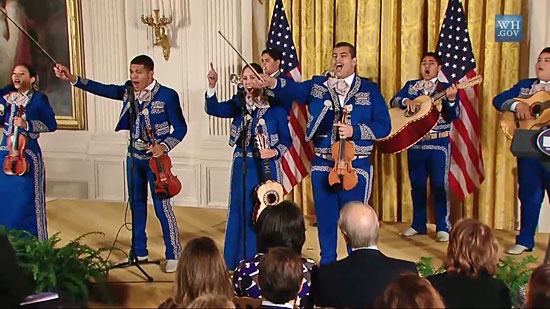
A rousing performance in the East Room is the latest honor for the Mariachi Master Apprentice Program.
Every performer loves a standing ovation. And for a troupe of young mariachis from the northeast San Fernando Valley, the only thing better than bringing a White House audience to its feet was having Michelle Obama in the front row as Applauder-in-Chief.
Put your hands together for the city of San Fernando’s Mariachi Master Apprentice Program, fresh from an engagement at 1600 Pennsylvania Avenue, where the group received a prestigious National Arts and Humanities Youth Program award worth $10,000, and enough incredible moments to last a lifetime—from first trip in an airplane to first visit to the Lincoln Memorial to first photo-op with the First Lady.
“It was surreal,” said 16-year-old Anthony Fino, who plays trumpet in the organization’s Mariachi Tesoro performance ensemble, which wowed ‘em in Washington, D.C. over the Thanksgiving break.
“As an educator, you can’t simply prepare for that kind of emotional hurricane, the feeling of standing in the White House,” said Sergio Alonso, one of the group’s musical instructors. “Gosh, how can you even envision playing in an atmosphere like that?” (A recent gig at Disneyland was also pretty cool. Next stop: the Board of Supervisors, where they’re being honored on January 15.)
The national award recognizes after-school “arts and humanities programs that celebrate the creativity of America’s young people, particularly those from underserved communities.”
The San Fernando group, started on a shoestring twelve years ago, certainly fits the bill. It brings together local kids with professional musicians, including those who’ve played with the legendary Nati Cano, a co-founder of the organization with Virginia Diediker, the city of San Fernando’s cultural arts supervisor.
The rigorous program doesn’t just introduce students to the cultural and musical richness of the mariachi tradition; it also gives them a leg up on future academic and professional success.
“We are helping these young musicians learn life skills, through the discipline that music provides,” Diediker said.
Its participants have a stellar graduation record, in an area where only 58% of students finish high school. Some, like 17-year-old Ernesto Lazaro, hope to use their mariachi talents as a springboard to studying music at a famed conservatory like Juilliard. Others head in another kind of professional direction, like Stefanie Espinoza, a UCLA freshman who aims to become a surgeon.
Espinoza, 19, who plays violin and sings with the ensemble, is still feeling a motivational buzz from the group’s White House debut.
When she stepped forward to solo on “¡Viva Mexico, Viva America!” as part of the medley the group performed in the East Room on November 19, Espinoza smiled and looked directly at the First Lady.
“She looked at me and I looked at her. She looked so great,” said Espinoza, who’s majoring in physiological science. Equally thrilling: being praised by the First Lady for choosing to study science.
In honoring this year’s 12 award-winning groups for pushing students toward excellence, often against long odds, Obama also threw down a challenge to the young artists:
“Your job now is to pass it on—to find someone in your life that you’re going to mentor, that you’re going to pull up. And whether it’s in the arts or whether it’s academically, your job is to find the next you.”
That resonated with Fabian Narez, 17, who pays it forward by coaching younger students, members of the organization’s “Tesoritos” program, on the violin.
For Narez and many of the other musicians, mariachi is a way to connect with their heritage—and their parents’ and grandparents’ music, even if many of their peers are more into rap or hip-hop.
“The school’s 98% Hispanic. It’s part of our roots,” Narez said. And even if he ends up with a business degree and achieves his dream of becoming a CEO, he said, he intends to keep the mariachi tradition alive.
“I would love to keep performing till the day I die,” he said. “It’s one of my many dreams.”
There’s also a certain “big musician on campus” status that erupts when you return to your high school with a White House gig under your belt.
“Some of them were pretty jealous, to tell you the truth,” said San Fernando High School student Alejandro Ascencio, 15, who performs in the group along with his two brothers. “Everybody knows about it and would like to be in it.”
Watch their performance in this White House video.
Posted 1/9/13




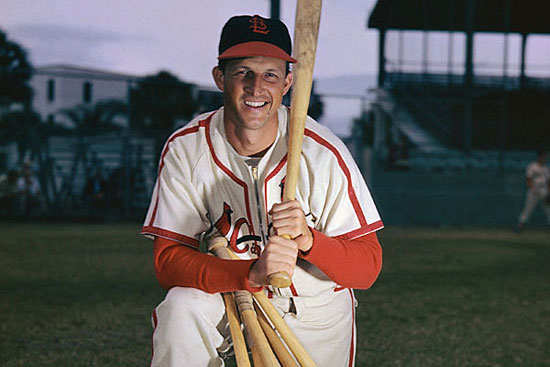
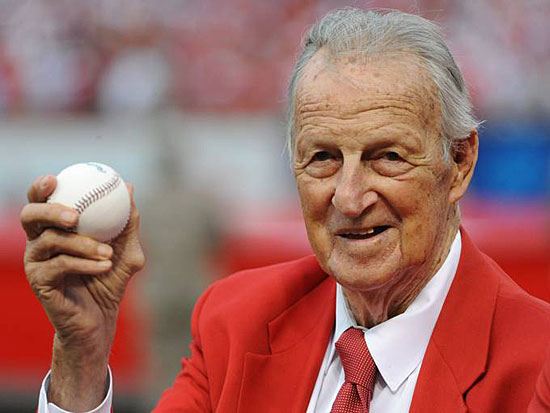

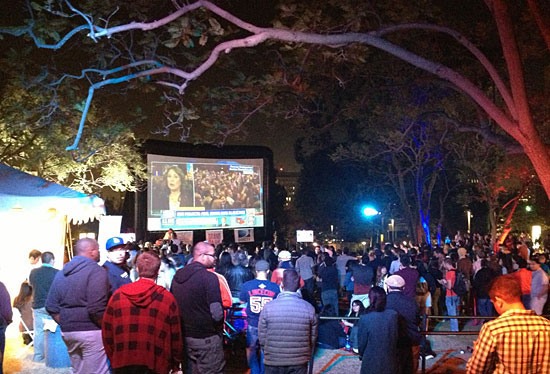
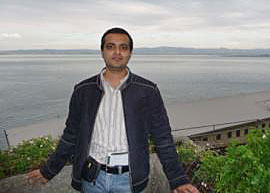
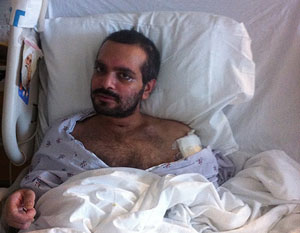
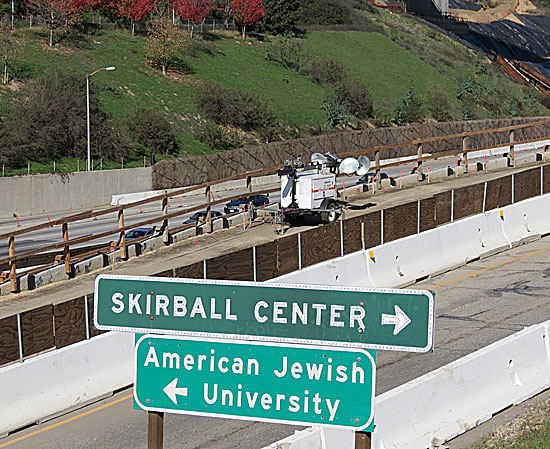
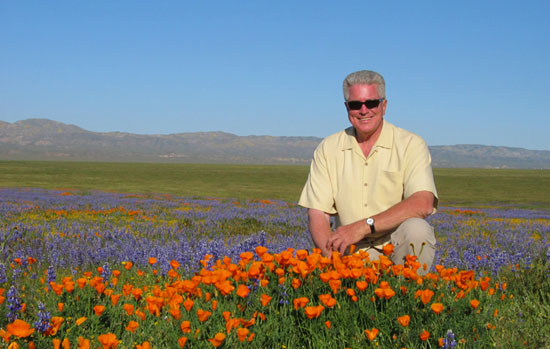
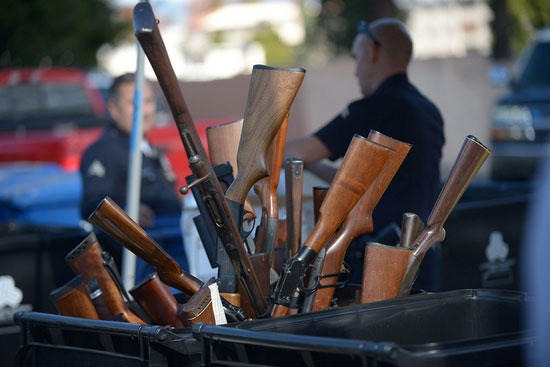
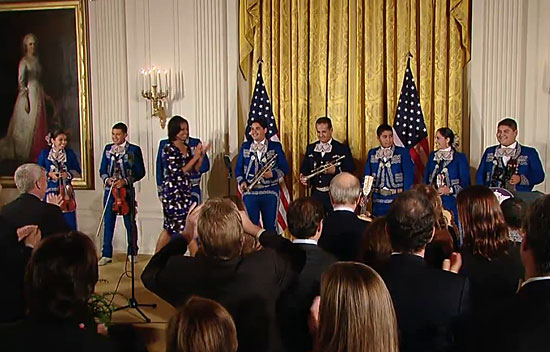





 Check for the latest closure information
Check for the latest closure information








